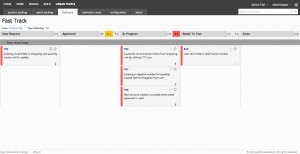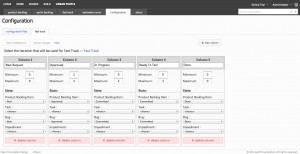Urban Turtle 2012 Extends TFS & Introduces Fast Track
Building on the success of our market leading agile planning and task board, Urban Turtle 2012 extends TFS to facilitate backlog estimation and management of sudden, but critical activities that appear during a sprint (think escalated support request). Let’s take a closer look…
Estimation Board – Speed up and Simplify Agile Estimating
Introduced in an earlier post, the estimation board supports agile estimation by illustrating each story’s size relative to others. Urban Turtle's estimation board allows product owners and developers to rapidly size backlogs and if necessary, recalibrate sizing. The team can see stories that need to be estimated, visualize relative size, and quickly identify large stories that need to be split. Using the Urban Turtle estimation board not only saves your team time, it also improves estimates and because it’s built on TFS, eliminates data entry (yeah!).
Fast Track – Very Cool
Fast Track was conceived for agile teams that provide both product development as well as escalated customer support (internal or external). Fast Track allows the team to manage both emergent and urgent tasks that are unplanned. Ever heard of Scrum-ban (a mix of Scrum and Kanban frameworks)? This feature will help you make it real!
If your development team does considerable out of sprint activity (out of necessity) --- Fast Track is for you! You can now prioritize these tasks and development work items together in the same product backlog. You can select any item from the product backlog and drag it to the Fast Track board at any time during a sprint. Doing so provides a clear picture of the impact support or other requests have on the team’s sprint goals. Also, it enhances visibility throughout the sprint, across activities, whether they are planned in the sprint or not.
How Do I use Fast Track?
If you are already using Urban Turtle 2012 or have requested a free trial, turning on Fast Track is simple. From the Configuration tab, Urban Turtle will automatically set-up everything with a simple click. By initiating Fast Track, a new iteration will be created and a new field will be added to each work item type (that is, to ID the work item column). Next, it’s only a matter of configuring Fast Track columns to represent your desired workflow. You can add the columns you want, rename and move them, create workflow rules, delete a column, set the WIP limits (minimum and maximum) as well as set the state associated to any column. Finally, a color alert will be activated in the Fast Track when the number of work items in a column either exceeds your WIP limits.
To conclude, while most agilist are reluctant to accept work outside a sprint, for some organizations it’s simply not possible (or realistic) to avoid (“why” is for another post). With that in mind, based on practical real world observations, we realized the market need to improve the management and visibility of “all” activities throughout an entire sprint. To that end, we are pleased to deliver Fast Track for TFS.

